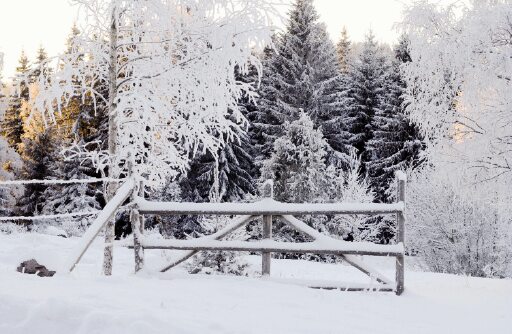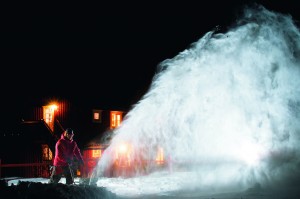Yesterday, I saw my first snow flurry of the season. It wasn’t much, nothing to write home about and, rather like my first coffee of the day, it didn’t last long and had soon degraded into a shallow wet sludge, but it did make me think about what was going on elsewhere, and the weather in the coming weeks.
 “The north wind doth blow and we shall have snow…” as the children’s rhyme starts, and, of course, some people have got it already. So how to keep calm and carry on when your driveway is hidden under a white blanket? The answer, for an increasing number of people, is a snow blower.
“The north wind doth blow and we shall have snow…” as the children’s rhyme starts, and, of course, some people have got it already. So how to keep calm and carry on when your driveway is hidden under a white blanket? The answer, for an increasing number of people, is a snow blower.
But which snow blower? There is a bewildering array of models, drive types, prices, functions and features out there. However, if you read on, I will attempt to gently, and as briefly as I can, guide you through them, so you can make an informed choice when the white stuff finally hits the fan.
What is a Snow Blower?
A snow blower, or snow thrower as they are sometimes known, (I am going to use snow blower) is a machine that scoops up snow or ice, with some kind of auger, and throws or blows it somewhere else, through an exit chute, leaving your path, patio, driveway or even lawn, clear and safe.
What Types of Snow Blower are there?
There are, technically, two types of snow blowers; single stage and dual stage, but more of that in a moment. Within these two categories, snow blowers can be very roughly divided into four types:
1. Pedestrian electric (always single stage and here are some examples)
2. Pedestrian petrol single stage (to view some click here)
3. Pedestrian petrol dual stage (sometimes referred to as “two stage” and we have examples here & here)
4. Commercial (roughly consisting of the larger pedestrian petrol machines and large-scale ride-ons)
What’s the Difference between Single & Dual Stage Snow Blowers?
So, single stage, dual stage? What’s that all about then? It’s actually more straightforward than you might think.
Single-stage snow blowers are pretty much always propelled forwards by a simple front auger, usually made of rubber, tough rubber-style plastic, or steel with rubber blades. This auger scoops up the snow and throws it up and out of an exit chute. Single-stage machines are, in general, suitable for small domestic premises.
Dual-stage snow blowers are usually self-propelled, mostly driven by petrol or diesel, and have two snow clearing devices. A front auger, usually toughened metal that breaks up the snow and sends it back to the secondary device.
The secondary device is an impeller – rather like a robust fan – that spins and further breaks up the snow, throwing the stream of broken snow up the exit chute and preventing clogging. This impeller usually propels snow further than a single-stage machine can.
A dual-stage snow blower is usually capable of removing both ice and snow, including compacted snow from far larger premises and on a wider variety of surfaces.
I hope that is clear. So which is right for you?
Should I choose a Single Stage or Dual Stage Snow Blower?
Very basically, if you live in a small or medium suburban house or village cottage with a normal-sized tarmac path or drive, and you just need to clear the drive or path to a fairly busy, or snow-cleared road, you are probably looking for a single-stage machine. Especially if you are just dealing with a light fall of snow.
 If you live in the Highlands of Scotland in a remote hilly area that resembles the final location of ‘Skyfall’, where the snow comes down like confetti at a royal wedding, you are probably going to need a dual-stage machine.
If you live in the Highlands of Scotland in a remote hilly area that resembles the final location of ‘Skyfall’, where the snow comes down like confetti at a royal wedding, you are probably going to need a dual-stage machine.
If you own pretty much any kind of business with a car park or a forecourt, a variety of walkways or maybe lawns, courts or greens, you are more than likely going to need a dual-stage machine.
Well, I said it was basic. There are, of course, many stages between. For example, just recently a nearby primary school bought a single-stage electric blower from us, largely I think because of the noise issue (electrics will always be quieter than petrol machines and little delicate ears were being considered) but I digress: the main point is that single-stage machines are generally designed for lighter falls of snow and for smaller premises.
Electric or Petrol?
Electric models are always single-stage and are great for low noise, so neighbours, children (as I have mentioned) and patients in hospitals and care homes can get some peace and quiet while you happily chuck snow around the grounds. They are also low maintenance and have lower fuel costs, but they are not much good if you have a back patio the size of the Olympic park and the nearest socket is in the front room.
Petrol models tend to be dual-stage, are nearly always more powerful, are cable-free, of course, and can go anywhere.
On What Type of Surfaces can I use a Snow Blower?
A single-stage snow blower is better on even surfaces, like tarmac, because on, for example, a pebbled drive, with its auger touching the ground, it may well start picking up stones and flinging them at the headlights of your neighbour’s precious Aston Martin.
Dual-stage blowers are capable of clearing on a larger range of surfaces.
In fact, while we’re on the subject, the surfaces issue is an interesting one. As I have illustrated, single-stage snow blowers with their rubber, or rubber-bladed, augers are very good at clearing right down to the surface – ‘Back-To-Black’ as it is called in the industry. Dual-stage machines generally have metal augers and you don’t want them scraping along the ground as they, or your drive, wouldn’t last long. They usually have a front hood (snow intake hood) fitted with devices called ‘snowshoes’ at the sides. The hood skates along on these, ahead of the rear wheels. The snowshoes are usually adjustable, so you can raise or lower the hood and clear snow from grass, pebbles or even the sandpit if you wish.
Working Width & Intake Height
Obviously, the working width of a snow blower is quite important. The wider the auger and hood, the more clearing you can get done. In general, and it is approximate, working widths of single-stage machines tend to be around 45 – 53cm, with dual-stage widths around 56 – 85cm.
Just as important is the height of the hood, the snow intake height. It is not a good move to plough into a 50cm drift with a 25cm machine. Single-stage heights are around the 25 – 33cm range with dual-stage varying between 41 – 56cm. These are, of course, very general but are important to bear in mind.
Another thing to bear in mind is what is under the snow. I have touched on this before, regarding surfaces, but it is really important to know what is lurking beneath the white and frosty before you clear. It can be hazardous to go ‘off piste’, as it were, as unknown obstacles can cause real damage, so following the maxim, “ If you don’t know what is under the snow… don’t go!” is always a good idea!
Obviously, I have mainly been discussing pedestrian models, but there are premises, and occasions, that require the ‘big boys’. Large-scale ride-on snow blowers are ideal for big businesses, distribution centres, very large or stately homes, colleges, leisure facilities, airfields, airports and retail warehouses.
These large snow blowers tend to be multi-purpose vehicles with heavy-duty snow blower attachments, which can be single- or dual-stage, but generally have working widths of 90cm or so. (Incidentally, these models will often have snowplough and snowbrush attachments available, as well as gardening and other attachments, so they can be incredibly good value as all-year-round workhorses.)
What are the Main Features to Consider?
Features and functions change across the ranges and even within the single-stage and dual-stage categories there are many features and functions to choose from. Let’s have a look at a few of these that you might want to check out.
Chute rotation – snow exit chutes usually rotate, some to a lesser degree than others (pun definitely intended). This means you can direct the stream of broken snow where you want it, and not launch it at an unsuspecting postman. A 180° rotation is fairly standard, but there are some that go up to 200°, 270° and even 300°.
Control of the rotation varies; from manual adjustment – where you lean forward, or go round from the handlebars and turn the chute – to remote electric control activated from your operating position. But you will more than likely find, in many mid-range models, that it is done with a handy lever that is either handlebar mounted or that you can reach fairly easily. Pitch control – or how high or low you want the stream – tends to be manual but is automated on some top models. I guess people don’t feel the need to alter it as often as the rotation.
Adjustable snowshoes – worth mentioning again, as these enable you to vary the height of the hood and clear snow and ice from awkward  surfaces like gravel, pebbles and the local football club’s artificial football pitch.
surfaces like gravel, pebbles and the local football club’s artificial football pitch.
Drive systems – the most basic powered models will only have forward motion and occasionally reverse, but most will have some kind of gearing system, ranging from a couple of forward and a reverse gear to multiple forward and reverse gears, all the way up to hydrostatic models. Hydrostatic drives allow detailed, infinite control over speed both forward and reverse. This can be very useful for manoeuvring in and out of tight spaces, difficult corners and for clearing near edges and obstacles.
Recoil starts – obviously only on petrol models and very common, but you will often, if not usually, find the manufacturer has provided an oversized handle so you can keep your gloves on while pulling – thoughtful.
Tyres/Tracks – the good quality machines, particularly the heavy-duty dual-stage models often have special snow tyres, great for grip and purchase, and you will also find models with caterpillar tracks – very good for manoeuvrability and zero turns.
Ergonomics – adjustable handles so you can work at the right height and shaped handles with comfort grips – these are well catered for generally, particularly as you go up through the ranges.
Electric starts – these feature on some models and are great for reducing effort – just press and get on with it.
Headlights – a great advanced feature enabling you to stay out and clear snow long after bedtime. Useful when you are clearing in blizzard conditions too.
At the very top end, you will even find features like heated handles, power steering on heavy ride-ons and, in some large models like the Stiga Titan machines, heated cabins and adjustable comfort seats. Generally, with top manufacturers who know what cold is, your comfort is well taken care of – though I have yet to find a model with a hot chocolate machine and a hipflask holder.
Which Brand of Snow Blower?
There are, as I mentioned earlier, a lot of models around, and it so happens that MowDirect are the UK’s leading supplier of pedestrian snow blowers and offers the widest range available online.
That’s not merely a plug; it means that we have been working with, and learning about, these machines for a while now. Subsequently, we stock the UK’s two most popular brands – Stiga and MTD.
It is no coincidence that these two companies hail from, respectively, Sweden and the USA, where they have, to quote a Teutonic acquaintance of mine, “…real snow, not the light dusting of icing sugar that stops all your trains twice a year ”. Hmm. She obviously doesn’t live in the Lake District.
As well as selling machines from these two snow management giants, we also sell specialist brands like Bertolini, Cub Cadet, Wolf-Garten, McCulloch and even our own fine machine, the MD SnowCAT, a caterpillar tracked top-of-the-range beast that has a 70cm working width and can handle heavy snow. More information all our snow blower brands can be found here.
Further Advice on Snow Blowers
Anyway, I hope that I have given you some useful information and advice regarding these machines. Have a look at our wide range on the site. Also, there are videos of snow blowers in action here, here and here as well as on our YouTube station, MowdirectTV.
If you want the personal touch, please feel free to e-mail us on [email protected] or call and speak to one of our experts on 0845 4588 905 between 9am and 5pm Monday-Friday.
Happy blowing.



